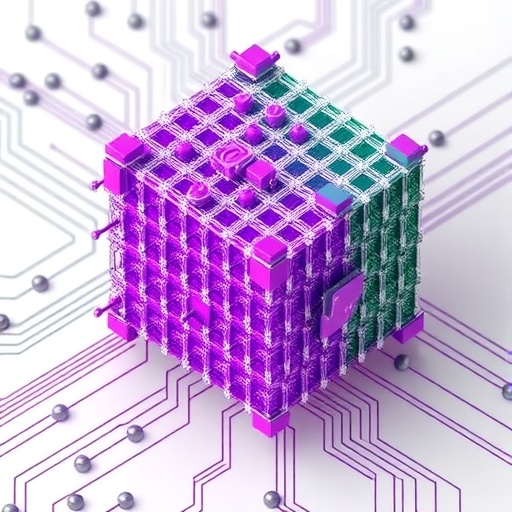In the depth of modern computational challenges lies a revolutionary leap in technology: using neuromorphic hardware to address complex numerical applications with unparalleled efficiency. A recent study unveils the groundbreaking NeuroFEM system, which leverages the unique characteristics of neuromorphic computing to directly implement the solutions of sparse linear systems. This approach signifies a paradigm shift in how intricate problems can be tackled, not only demonstrating the potential of neuromorphic hardware but also doing so with minimal additional user effort.
The researchers embarked on an ambitious project where they sought to solve more complicated Finite Element Method (FEM) problems beyond standard two-dimensional scenarios, using the NeuroFEM system operating initially on conventional CPUs. Their first endeavor involved generating a two-dimensional domain with significant topological complexity. This was achieved by introducing holes into a standard disk shape, creating a more intricate mesh structure that varied spatially in resolution. This step was no trivial task, as it challenges traditional methods of numerical computing that typically struggle with such irregularities in mesh design.
To encapsulate the complexities of physical phenomena, the researchers employed Dirichlet boundary conditions—fixing the temperature along the outer boundary—coupled with Neumann boundary conditions dictating heat flux at the inner holes. These conditions mirror real-world physical constraints, creating a multifaceted layer of complications that standard computational models are often ill-equipped to resolve. As the study progresses, the results revealed that NeuroFEM effectively managed to resolve these systems, producing solutions that were remarkably consistent with those derived from conventional computational methods.
The accuracy of the results demonstrates not only the stability of NeuroFEM in solving non-trivial problems but also indicates its readiness for practical application across various fields, such as civil engineering, aerospace, and materials science. The alignment of NeuroFEM solutions with traditional numerical solutions sheds light on the robustness of neuromorphic methods, hinting at their vast potential for integration into existing computational frameworks.
Continuing the exploration into complex solutions, the study illustrates the application of NeuroFEM in three-dimensional problems. A static linear elasticity problem was presented, depicting the deformation of a three-dimensional object under its own gravitational weight, constrained by a fixed boundary condition on one face. Unlike simpler cases, this three-dimensional problem represented a more complex system of partial differential equations (PDEs) and highlighted the advantages of using topologically non-trivial tetrahedral meshes.
The NeuroFEM system once again demonstrated its prowess, generating a vector field to depict shape displacement as a response to the applied gravitational force. This was a significant leap from the scalar field solutions in the two-dimensional context. The insights gained from these analyses revealed that the system could efficiently interface with conventional FEM tools like Gmsh and SfePy, effectively translating complex numerical problems directly into neuromorphic processing tasks.
Such a seamless integration marks a pivotal moment in the relationship between neuromorphic computing and established scientific methodologies. The interconnectivity of NeuroFEM with traditional scientific computing packages greatly diminishes the barriers faced by researchers and engineers looking to harness the advantages of neuromorphic technology.
Moreover, the results from this study raise prospects for future optimizations and refinements of the NeuroFEM system. While the discrepancies observed between NeuroFEM solutions and conventional solvers remained small, the potential for further enhancing accuracy and efficiency in solving complex numerical problems is extensive. The continuous evolution of this technology suggests a future where neuromorphic hardware could become a standard in high-performance computing.
As the era of neuromorphic computing unfolds, the implications for research and industry alike are boundless. The ability to process complex equations in real-time with significantly reduced computational overhead stands to revolutionize industries that rely heavily on advanced simulations, such as structural analysis, fluid dynamics, and thermodynamics.
This cutting-edge approach is not simply about achieving computational feats, but also involves transforming how researchers conceptualize problems and solutions. By employing a neuromorphic framework, they can focus on the intricacies of the physical systems being modeled, confident that the hardware can manage the underlying numerical complexities with finesse.
As the study progresses and more applications for NeuroFEM emerge, the research community will undoubtedly explore novel uses for neuromorphic hardware. It is conceivable that this technology will eventually permeate everyday computational tasks, fundamentally altering the landscape of numerical problem-solving in science and engineering.
In conclusion, the use of the NeuroFEM system as an efficient tool for solving complex FEM problems showcases the power of neuromorphic computing. The successful application in both two-dimensional and three-dimensional contexts reaffirms the technology’s capacity for real-world applications, paving the way for a future where advanced computing methodologies become synonymous with efficiency and accessibility.
The research conducted not only reflects current advancements but also plants the seeds for future innovations in computational science. The journey from theoretical frameworks to practical implementations will be closely watched, as the promise of neuromorphic systems unfolds and achieves greater heights.
This study indeed marks a thrilling step in an ongoing quest for computational efficiency, illuminating a path forward for a generation of researchers and engineers who will harness neuromorphic computing to tackle the most formidable challenges in numerical analysis.
Subject of Research: Neuromorphic computing applications in finite element problems.
Article Title: Solving sparse finite element problems on neuromorphic hardware.
Article References:
Theilman, B.H., Aimone, J.B. Solving sparse finite element problems on neuromorphic hardware.
Nat Mach Intell (2025). https://doi.org/10.1038/s42256-025-01143-2
Image Credits: AI Generated
DOI: https://doi.org/10.1038/s42256-025-01143-2
Keywords: Neuromorphic computing, finite element method, computational efficiency, numerical analysis, machine learning.
Tags: addressing intricate engineering problemsadvanced computational techniquesboundary conditions in numerical simulationschallenges in numerical computingcomputational efficiency in neuromorphic hardwarefinite element method innovationsirregular mesh structures in FEMNeuroFEM system for FEM problemsneuromorphic computing applicationssparse linear systems solutionstackling complex numerical applicationstopological complexity in mesh design





